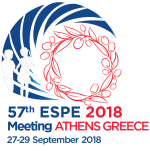
57th Annual ESPE
Athens,
Greece
27 Sep 2018 - 29 Sep 2018

Poster Presentations
Growth & Syndromes P2
hrp0089p2-p239 | Growth & Syndromes P2 | ESPE2018
Heart and Aorta Anomalies in Turner Syndrome and Relation with Karyotype
Kardelen Aslı Derya , Darendeliler Feyza , Gencay Genco , İnce Zuhal , Aliyev Behruz , Ozturan Esin Karakılıc , Abalı Zehra Yavaş , Poyrazoğlu Şukran , Nişli Kemal , Baş Firdevs
hrp0089p2-p240 | Growth & Syndromes P2 | ESPE2018
The Validation of an Automated Bone Age Assessment in Girls with Turner Syndrome – A Pilot Study
Soucek Ondrej , Lebl Jan , Maratova Klara , Zemkova Dana , Sumnik Zdenek
hrp0089p2-p241 | Growth & Syndromes P2 | ESPE2018
Turner Syndrome and Autoimmune Thyroid Disease: Pecularities of Evolution in 93 Turner Syndrome Patients
Dumitrescu Cristina , Gherlan Iuliana , Radomir Lidia , Vintila Madalina , Brehar Andreea , Caragheorgheopol Andra , Purice Mariana , Procopiuc Camelia
hrp0089p2-p242 | Growth & Syndromes P2 | ESPE2018
Unusual Clinical Manifestations in Turner Syndrome
Akulevich Natallia , Makarava Yulia , Ershova Larissa , Kunavitch Irina
hrp0089p2-p243 | Growth & Syndromes P2 | ESPE2018
Effect of Combined GH and Estrogen Treatment on the Lipid Profile and Systolic Function of the Left Ventricle in Girls with Turner Syndrome (TS)
Shiryaeva Tatiana , Nagaeva Elena , Pankratova Maria , Chikulaeva Olga , Volevodz Natalia , Peterkova Valentina
hrp0089p2-p244 | Growth & Syndromes P2 | ESPE2018
Familial Turner Syndrome: Case Report
Dacal Jimena Lopez , Villanueva Mercedes , Enacan Rosa , Brunetto Oscar , Figueroa Veronica
hrp0089p2-p245 | Growth & Syndromes P2 | ESPE2018
Clinical Review of Seven Patients Affected with 49,XXXXY Syndrome
Sanchez Jacobo Perez , Collado Raquel Corripio , Escofet Concepcion , Brun Carme , Gabau Elisabeth
hrp0089p2-p246 | Growth & Syndromes P2 | ESPE2018
Poor Weight Gain in Prader-Willi Syndrome – Not Always Over-restriction Consider Coeliac Disease
Lateva M , Kassim A , Meade C , Maher R , McCrann A , Roche E
hrp0089p2-p247 | Growth & Syndromes P2 | ESPE2018
GH Unmasked Laryngomalacia and worsened Obstructive Sleep Apnea in Infants with Prader-Willi Syndrome
Salehi Parisa , Wrede Joanna E , Johnson Kaalan E , Chen Maida L
hrp0089p2-p248 | Growth & Syndromes P2 | ESPE2018
How Frequent Are Growth Charts Used in Paediatric Clinics? An Audit of Growth Chart Use in a District General Hospital in Scotland
Punton Andrew , Britton Nicola , Schulga Jiohn
hrp0089p2-p249 | Growth & Syndromes P2 | ESPE2018
GrowInform – A Campaign for Early Diagnosis and Treatment of Growth Disorders
Stoycheva Rosica , Iotova Violeta , Galcheva Sonya , Yordanova Galina , Tsochev Kaloyan , Ivanova Antoaneta , Karamfilova Teodora
hrp0089p2-p250 | Growth & Syndromes P2 | ESPE2018
Growth and Body Composition of Term Healthy Indian Infants from Birth to 2 Years of Age
Jain Vandana , Kumar Brijesh , Kurpad Anura
hrp0089p2-p251 | Growth & Syndromes P2 | ESPE2018
Growth, Body Composition and Metabolic Parameters during Childhood in a Cohort of Children Born with a Small for Gestational Age
Loredana Marcovecchio M. , Gorman Samantha , Murgatroyd Peter , Ong Ken , Dunger David , Beardsall Kathryn
hrp0089p2-p252 | Growth & Syndromes P2 | ESPE2018
Final Results of NordiNet® International Outcome Study: Key Outcomes in Paediatric Patients
Polak Michel , Blair Jo , Rohrer Tilman R. , Pietropoli Alberto , Tonnes Pedersen Birgitte , Savendahl Lars
hrp0089p2-p253 | Growth & Syndromes P2 | ESPE2018
Influence of Puberty on Adult Height of SGA Children Treated with GH
Lopez-Siguero Juan P. , Munoz-Martinez Pablo , Borras-Perez Ma Victoria , Alvarez-Casano Maria , Sanchez-Moreno Sonia , Martinez-Aedo Ma Jose
hrp0089p2-p254 | Growth & Syndromes P2 | ESPE2018
Burden and Impacts of Daily Recombinant Human Growth Hormone (r-hGH) Injections in Growth Hormone Deficient (GHD) Paediatric Patients
Loftus Jane , Pleil Andreas , Lamoureux Roger , Turner-Bowker Diane , Yaworsky Andrew , Kelly Masami , Love Emily , McNamara Michelle , Palladino Andrew
hrp0089p2-p255 | Growth & Syndromes P2 | ESPE2018
Clinical and Cost-Effectiveness of GH Treatment for Children in Wales
Pop Raluca-Monica , Warner Justin T. , Gregory John W.
hrp0089p2-p256 | Growth & Syndromes P2 | ESPE2018
Bone Mineral Density and Body Composition of Young Adults Who Were Born Small for Gestational Age and Treated with Growth Hormone, after Treatment Completion
Ascaso Matamala Angela , Trujillano Lidon Laura , Calero Polanco Angelica , Matute-Llorente Angel , Bueno Lozano Gloria
hrp0089p2-p257 | Growth & Syndromes P2 | ESPE2018
Clinical Effectiveness and Cost-Effectiveness of Somatropin Treatment for Short Children in Egypt: Analysis of 1-Year Data
Ibrahim Amany , Atef Abeer , Badawy Nora , Helmy Eatemad
hrp0089p2-p258 | Growth & Syndromes P2 | ESPE2018
Clinical and Molecular Analyses of 24 Patients with Beckwith-Wiedemann SYNDROME
Lu Wei , Wu Bingbing , Zhou Wenhao , Zheng Zhangqian , Zhang Miaoying , Cheng Ruoqian , Luo Feihong
hrp0089p2-p259 | Growth & Syndromes P2 | ESPE2018
Unusual Case of Combination of Beckwith-Wiedemann Syndrome and SHOX Gene Deficiency
Cassano Gilda , Osimani Sara , Pajno Roberta , Pitea Marco , Partenope Cristina , Russo Silvia , Pozzobon Gabriella
hrp0089p2-p260 | Growth & Syndromes P2 | ESPE2018
An Irish Regional Study of Paediatric Growth Hormone Deficiency (CO-GHD): Classification of Causes and Factors Associated with Persistent GHD at Transition
Grace Mariana , Joyce Caroline , Morissey Rose , Moore Michael , O'Connell Susan
hrp0089p2-p261 | Growth & Syndromes P2 | ESPE2018
Two Different Variants of Short Stature Homeobox-Containing Gene (SHOX) Mutation in the Same Family
Graf Stefanie , Santi Maristella , Losekoot Monique , Fluck Christa E.
hrp0089p2-p262 | Growth & Syndromes P2 | ESPE2018
Identification of a Novel Heterozygous ACAN Mutation in a Patient with Non-Syndromic Short Stature
Partenope Cristina , Gallo Dario , Damia Chiara Maria , Adavastro Marta , Fioretti Lorenzo , Pitea Marco , Weber Giovanna , Pozzobon Gabriella
hrp0089p2-p263 | Growth & Syndromes P2 | ESPE2018
Genetic Investigation of SHORT Stature: A Case Report of Complex Constitutive Rearrangement Involving Chromosome 15
Pinto Renata Machado , Minasi Lysa Bernardes , Pinto Irene Plaza , Silva Juliana Ferreira da , Cunha Damiana Mirian da Cruz , Ribeiro Cristiano Luiz , Silva Claudio Carlos da , Cruz Aparecido Divino da
hrp0089p2-p264 | Growth & Syndromes P2 | ESPE2018
Targeted/Exome Sequencing Identified Mutations in 55 Chinese Children Diagnosed with Noonan Syndrome and a Autosomal Recessive form Associated with LZTR1 Variants
Li Xin , Yao Ruen , Chen Yao , Chang Guoying , Ding Yu , Li Juan , Shen Yiping , Wang Xiumin , Wang Jian
hrp0089p2-p265 | Growth & Syndromes P2 | ESPE2018
A Novel Heterozygous Missense Variant in the LZTR1 Gene as a Cause of Noonan Syndrome
Dateki Sumito , Watanabe Satoshi , Yoshiura Koh-ichiro , Moriuchi Hiroyuki
hrp0089p2-p266 | Growth & Syndromes P2 | ESPE2018
A Novel FGFR1 Mutation in Kallmann Syndrome with Growth Hormone Deficiency
Tornese Gianluca , Pellegrin Maria Chiara , Pavan Matteo , Faleschini Elena , Barbi Egidio
hrp0089p2-p267 | Growth & Syndromes P2 | ESPE2018
Clinical and Molecular Characterization of Eight Chinese Children with Cornelia de Lange Syndrome Using Targeted Next Generation Sequencing
hrp0089p2-p268 | Growth & Syndromes P2 | ESPE2018
A New Mutation in IHH Gene Causing Severe Short Stature
Festa Adalgisa , Luongo Caterina , Grandone Anna , Cirillo Grazia , Greco Federica , Torella Annalaura , Nigro Vincenzo , Giudice Emanuele Miraglia Del
hrp0089p2-p269 | Growth & Syndromes P2 | ESPE2018
Case Report: Ellis Van Creveld Syndrome With a Novel Mutation
Sobu Elif , Demirkol Yasemin Kendir , Yılmaz Gulay Can , Ozcora Gul Demet , Yenigurbuz Fatma
hrp0089p2-p270 | Growth & Syndromes P2 | ESPE2018
A Homozygous Pathogenic Variant in the TRHR Gene in a Boy Who Presented With Severe Familial Short Stature and Central Hypothyroidism
Šnajderova Marta , Plachy Lukaš , Strakova Veronika , Elblova Lenka , Dušatkova Petra , Zemkova Dana , Lebl Jan , Pruhova Štěpanka
hrp0089p2-p271 | Growth & Syndromes P2 | ESPE2018
Unexpected Growth Patterns in Branchio-Oto-Renal Syndrome
hrp0089p2-p272 | Growth & Syndromes P2 | ESPE2018
Mild Autistic Spectrum Disorder in a 33 Year-old Male Japanese Patient with Temple Syndrome
Yatsuga Shuichi , Kagami Masayo , Matsubara Keiko , Kimura Takuro , Yatsuga Chiho , Mukasa Rio , Matsumoto Takako , Koga Yasutoshi
hrp0089p2-p273 | Growth & Syndromes P2 | ESPE2018
Seventeen-year Observation in a Japanese Female Case of Tatton-Brown-Rahman Syndrome: An Overgrowth Syndrome with Intellectual Disability
Miyoshi Yoko , Yamamoto Keiko , Nakano Yukako , Yamamoto Kenichi , Kubota Takuo , Ozono Keiichi
hrp0089p2-p274 | Growth & Syndromes P2 | ESPE2018
KBG Syndrome: Our Experience and Unreported Clinical Features
Scarano Emanuela , Tassone Martina , Tamburrino Federica , Graziano Claudio , Perri Annamaria , Stefanelli Francesca , Vestrucci Benedetta , Mazzanti Laura
hrp0089p2-p275 | Growth & Syndromes P2 | ESPE2018
Growth of Infants Born by Intracytoplasmic Sperm Injection (ICSI) Technique
Eldakrouri Ahmed Farouk , Ali Hamdy Alsayed , Alrifai Hilal , Soliman Ashraf
hrp0089p2-p276 | Growth & Syndromes P2 | ESPE2018
Earlier Mother’s Age at Menarche is a Risk Factor of Daughter’s Early Menarche and Short Stature in Young Korean Female: Epidemiologic Study
hrp0089p2-p277 | Growth & Syndromes P2 | ESPE2018
Pulling the Brakes – ‘Catch Down Growth’: A Phenomenon for Achieving Mid-parental Height Centile After Acquired, All-cause, Brain Injury
Kraus Fabian B T , Hindmarsh Peter C , Spoudeas Helen A
hrp0089p2-p278 | Growth & Syndromes P2 | ESPE2018
Effects of Inhaled Corticosteroids and Montelukast on Growth and BMI in Children with Asthma
Akin Onur , Yavuz Suleyman Tolga
hrp0089p2-p280 | Growth & Syndromes P2 | ESPE2018
Skeletal Disproportion and Growth Impairment in Glucocorticoid Treated Boys with Duchenne Muscular Dystrophy
Kao Kung-Ting , Joseph Shuko , Brown Sarah , Capaldi Nadia , Dunne Jennifer , Horrocks Iain , DiMarco Marina , McMillan Martin , Shepherd Sheila , Ahmed Syed Faisal , Wong Sze Choong
hrp0089p2-p281 | Growth & Syndromes P2 | ESPE2018
A Novel Mutation in the SLC2A2 Gene in a 19-Year-Old Female with Diabetes Mellitus and Renal Tubular Acidosis: A Therapeutic Conundrum
Sharari Sanaa , Al-Khawaga Sara , Hasnah Reem , Saraswathi Saras , Haris Basma , Saeed Amira , Mohammed Idris , Malik Riyaz , Hussain Khalid
hrp0089p2-p282 | Growth & Syndromes P2 | ESPE2018
Vesico-Ureteral Reflux and Effect on Growth Indices
Nicolas Georges , Hneineh Roula , Kalifeh Marie-Claude Faddous
hrp0089p2-p283 | Growth & Syndromes P2 | ESPE2018



